How Does A Wind Vane Work?
Construction
Construction
When constructing a weather vane, the design must be planned to allow for free movement about the vertical axis. The surface area of the design must be asymmetrical, unequal, which enables the smaller area to turn into the wind. However, the weight must be equally distributed on both sides of the axis of rotation to allow the wind vane to spin freely. The small end points in the direction from which the wind is coming, and the larger end points where the wind is going. The individual installing the wind vane would need to align the directional markers with the geographic directions of north, south, east and west. The directional markers allow observers to identify the wind direction easily.
Placement
Placement
In order to accurately display wind direction, weather vanes must be positioned high enough to avoid wind interference from other objects, buildings and trees. That is why they are usually sitting on top of poles or towers that are mounted on the roof of a building at its highest point. Observing wind patterns and changing directions may enable observers to make a simple forecast when considering other weather indicators.
History
History
Original wind vane designs were a Triton but changed to a weathercock with the conversion of the Roman Empire to Christianity. The weathercock is indicative of St. Peter's fall and suggests to onlookers the need to be watchful. Ornamental pointers graced the tips of early weather vanes. However, the use of modern technology has eliminated the need for manually reading the weather vanes, and therefore the tips have been reduced to simple arrows over time. The word vane came from an early Anglo-Saxon word, fane, meaning flag.
Limitations
Limitations
If a modern weather vane does not have the necessary weight balance, it cannot show the real direction of the wind. Therefore, a modern wind vane with an elaborate design is often just an architectural ornament.
Cite This Article
MLA
Fuller, Julia. "How Does A Wind Vane Work?" sciencing.com, https://www.sciencing.com/wind-vane-work-4673877/. 22 November 2019.
APA
Fuller, Julia. (2019, November 22). How Does A Wind Vane Work?. sciencing.com. Retrieved from https://www.sciencing.com/wind-vane-work-4673877/
Chicago
Fuller, Julia. How Does A Wind Vane Work? last modified March 24, 2022. https://www.sciencing.com/wind-vane-work-4673877/
